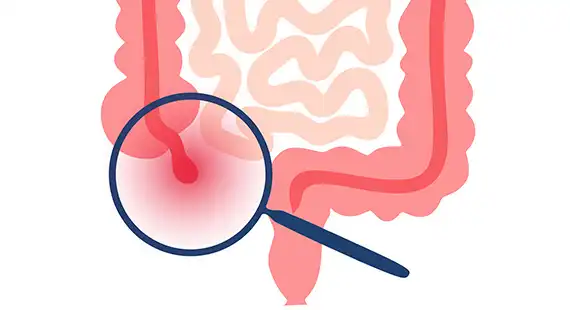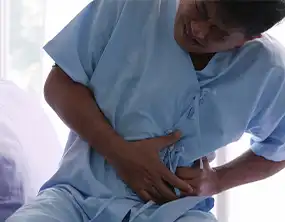Appendix Pain: Meaning, Causes, Symptoms, Diagnosis & Treatment
Appendix pain is the pain arising in the appendix located on the right side of the lower abdominal region. Appendix pain mainly occurs as a result of inflammation in the appendix, called appendicitis. An appendix is a finger-like structure or pouch projecting out from the end of the colon. Appendix pain increases when there is an increase in the inflammation of the appendix.

WHAT IS APPENDIX PAIN?
Appendix pain is the sudden pain in the right side of the abdominal region that begins from the navel and traverses to the lower abdomen. The appendix pain is felt intensely as a person walks or coughs.
An appendix is a finger-like structure or pouch projecting out from the end of the colon. Appendix pain increases when there is an increase in the inflammation of the appendix. Appendicitis cannot be prevented but it has been found to be less common in people who take fiber-rich diet like fruits and vegetables.

TYPES OF APPENDIX PAIN
Acute pain due to appendicitis
Appendix pain and other symptoms of appendicitis appear suddenly and are more severe.
1

Chronic pain due to appendicitis
Appendix pain and other appendicitis symptoms last longer than 48 hours but are comparatively mild and may go undetected or undiagnosed for weeks, months, or even years.
2

CAUSES OF APPENDIX PAIN
- Appendicitis (inflamed appendix)
- Injury to abdomen
- Blockage of appendix lining IBD (Inflammatory Bowel Disease)
SYMPTOMS
- Sudden abdominal pain (significantly on the right side)
- Nausea
- Vomiting
- Abdominal bloating
- Loss of appetite
- Constipation
- Diarrhoea
- Fever

DIAGNOSIS
It is important to diagnose abdominal pain as appendix pain, as there can be various reasons for abdominal pain. Usually, it is the location of the appendix that decides that the patient has appendix pain, and some other tests are done to diagnose appendicitis like:
Blood test
To examine the infection of the appendix.
Ultrasound
To check for swelling due to appendicitis
CT scan
To visualize the detailed images of the appendix and surrounding organs.
MRI scan
To look for inflamed appendix in pregnant ladies.
DO's
DONT's
TREATMENTS
NON-SURGICAL TREATMENTS

Appendix pain due to appendicitis can be treated non-surgically only if the problem is mild. Furthermore, non-surgical options for the treatment of appendix are recommended by the doctors if the surgery cannot be done for other health problems. Some of the non-surgical treatments for appendix pain are:
Antibiotics
To prevent infections of the appendix.
NSAIDs (Non-steroidal Anti-inflammatory Drugs)
To relieve pain in the abdomen until appendix removal surgery.
SURGICAL TREATMENTS

Appendectomy
The surgery to remove the appendix is called an appendectomy, which is performed under general anaesthesia. The surgery can be done either using surgical procedure:
Open traditional surgery
There are some cases where traditional open surgery is recommended to remove the appendix, like in case the appendix is burst. The open surgery includes one major incision made in the abdomen for appendix removal. The recovery time after open surgery is comparatively more.
Keyhole or laparoscopic appendectomy
It is the preferred surgical procedure for the treatment of appendix pain due to appendicitis, which can only be cured by removing the appendix. In the keyhole procedure, 3-4 small incisions are made in teh lower abdomen, and a laparoscope is inserted along with a small surgical tool that helps remove the appendix.
RISKS AND COMPLICATIONS
Intense appendix pain can cause serious health complications as a result of an appendix burst. The inflamed appendix may burst within the abdominal region, eventually infecting the peritoneum.
The condition in which the peritoneum gets infected is called peritonitis. Other complications arising from appendix pain caused by appendicitis are:
- Damage to internal organs
- Rapid heart rate
- Abdominal swelling
- Intense abdominal pain

IF LEFT UNTREATED
If the appendix pain is left untreated, it worsens with time. The inflamed appendix may burst and cause a serious health threat.
COST
Starting price of appendectomy (appendix removal surgery) in India is ₹30,000. The average cost of appendix surgery is between ₹50,000 to ₹60,000. The cost may vary depending on the type of surgical procedure, hospital facilities, and the city chosen for the surgery.
Financial Options
INSURANCE COVERAGE
Treatment for appendix pain done using appendix surgery is covered by health insurance.
Most of the time, the insurer will cover a particular amount for surgical treatment of the fistula. However, the amount to be covered under insurance depends on the type of policy.
It is important to know that medical treatment for fistula will not be covered under the insurance policy, it will only cover the cost or expenses of the surgical treatment, but to claim this, you will have to be hospitalized for 24 hours.

Know More About Appendix Pain
Appendix pain is the pain arising in the appendix located on the right side of the lower abdominal region. Appendix pain mainly occurs as a result of inflammation in the appendix, called appendicitis.
An appendix is a finger-like structure or pouch projecting out from the end of the colon. Appendix pain increases when there is an increase in the inflammation of the appendix.
Appendicitis cannot be prevented but it has found to be less common in people who take fiber-rich diet like fruits and vegetables.
Appendicitis is a condition that occurs when the appendix becomes inflamed and swollen. This can be caused by a blockage in the appendix, such as from a hard piece of stool or a small piece of food. The blockage can cause bacteria to grow, which can lead to infection and inflammation. Get the diagnosis from expert healthcare providers at Glamyo Health.
The most common symptom of appendicitis is a pain in the lower right side of the abdomen. The pain may start around the belly button and then move to the lower right side of the abdomen. The pain is usually constant and can be severe. Other symptoms of appendicitis may include:
- Nausea and vomiting
- Loss of appetite
- Fever
- Diarrhea or constipation
- Swollen abdomen
- Inability to pass gas
If you suspect that you or someone else may have appendicitis, it is important to seek medical attention immediately. Glamyo Health has expert surgeons to help with medical treatment, usually with surgery to remove the appendix.
In some cases, the appendix may rupture or burst, which can lead to a more serious condition called peritonitis. Peritonitis is an infection of the lining of the abdominal cavity and can be life-threatening. Symptoms of peritonitis may include severe abdominal pain, high fever, and rapid heartbeat.
 New Delhi
New Delhi  Bangalore
Bangalore  Mumbai
Mumbai  Hyderabad
Hyderabad  Pune
Pune  Chennai
Chennai 
